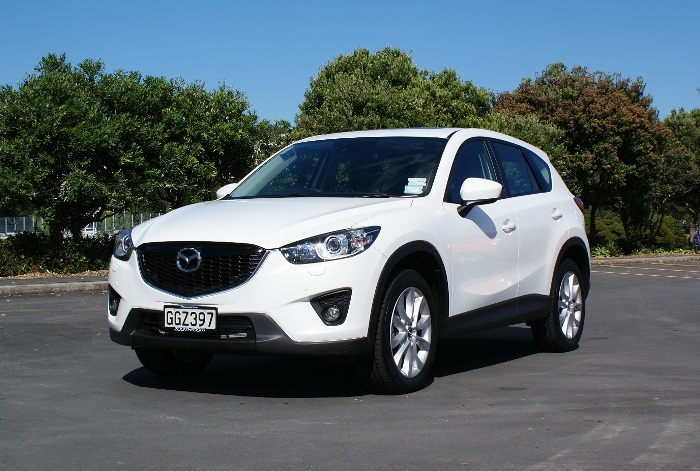
Ford Endura 2019 Car Review
We review the new Ford Endura
13 April 2012
If the budget runs to it, go for the SKYACTIVE-D, it’s worth paying the extra for. Our pick of the 2012 CX-5 range would be the AWD 2.2 litre GSX as a great all-round value for money package.

Impressive! That was our reaction to Mazda’s new CX-5 after piloting the new compact SUV out of central Wellington’s busy city traffic, taking the Hutt motorway out of town before turning off through the ‘burbs, then over the gravel-surfaced coastal road to Pencarrow Station, prior to heading across the steep and twisty Rimutaka’s, emerging out onto the wide open roads of rural Wairarapa.
A more diverse array of road surfaces and conditions would be hard to find within a couple of hour’s driving anywhere in the world, but the 2.2 litre, 129kW/420Nm SKYACTIV-D powered Mazda CX-5 we were pedalling felt like it was made for all of them.
Mated to a highly capable six speed auto with a manual shift function, the diesel pulls well from down low as expected, but where diesels often peak out at around 4,000 to 4,500rpm, we found the SKYACTIV-D revved way beyond that, well over 5,000rpm.
The new intercooled, turbocharged diesel engine is said to consume just 5.7L/100km, emitting 149g/km of CO2. It’s lively and frugal with very little intrusive noise. Although New Zealand legislation only requires Euro IV emission compliance, we’re told that the clean burning diesel engine has been designed with the future in mind, being capable of meeting the requirements of Euro VI.
Mazda’s engineers have worked their magic in the NVH department, and you’d be hard pressed to find a quieter SUV/Crossover, even at twice the price. And even at open road speeds on our good ol’ Kiwi course chip highways, in the cabin it’s quiet and refined, which matches the classical interior styling and the high quality fit and finish.
Mazda puts all this efficiency and low noise level down to the design and structure of both the body shell, which makes extensive use of high-tensile steels that are seven times stronger but considerably lighter than conventional panel steel, and the aluminium SKYACTIV engines, which at 14:1 compression ratio, the SKYACTIV-D is said to be the lowest compression ratio of any diesel car. The SKYACTIVE-G runs a 13:1 compression ratio, running on 91 octane juice.
Swapping into a petrol-powered SKYACTIV-G (Note the D for diesel and G for gasoline) for the run back to Wellington, we felt a little let down, given that the bar had been set particularly high with the oil-burner we’d experienced earlier. Still with the same impressive build quality, low noise level and poise offered by the excellent chassis, but with 114kW of power and 200Nm of torque on tap (less than half the torque offered by the SKYACTIV-D), it felt a little underwhelming, although fuel consumption and emission stats at 6.4L/100km and 148g/km are not to be sneezed at for a petrol-powered SUV.
Attending the local launch was Hideki Tanaka, Mazda Japan’s Programme Manager for CX-5. Having been with Mazda since 1984, he has a long list of successes under his belt, with particular highlights being the world beating original MX-5 in 1989, as well as the Mazda6 in 2002. He’s also had a hand in development of the CX-9, Mazda’s large SUV.
A keen cyclist, he outlined how his feel for the road gained from his experience on the bike has helped his understanding of vehicle handling, suspension tuning and dynamics. Certainly, the CX-5 would rate up there with the best in class dynamically, so maybe there’s something in this theory.
Interestingly, Mazda New Zealand’s predictions are for sales of only 30% diesel and 70% petrol models, however Hideki Tanaka thinks otherwise, saying he can see over half the CX-5’s customers opting for diesel. After driving both, we think he might be right.
Six models are on offer, four with the SKYACTIV-G and two with SKYACTIV-D power. Spec levels are high across the range, with all having the fuel saving i-stop, start/stop feature, Bluetooth and a 5.8 inch colour touch screen. Features such Blind Spot Monitoring, Lane Departure Warning and High Beam Control are standard in the CX-5 Limited, features generally reserved for high-end premium priced models.
Rear cargo space of 403 litres with the 60/40 split seats up and 1,560 litres with seats folded flat is quite cavernous in this sector, with interior space on a par with Mazda’s own CX-7, which will no longer be offered in our market. Those wanting a larger Mazda SUV can opt for the CX-9.
A couple of Front Wheel Drivers kick the range off, starting with a FWD 2.0 litre GLX at $39,690 and a FWD 2.0 litre GSX at $41,390. The remainder of the range are All Wheel Drive models, an AWD 2.0 litre GSX priced at $43,390 and an AWD 2.0 litre Limited with a retail sticker of $52,990.
Diesel models start at $46,990 with the AWD 2.2 litre GSX and top out with the AWD 2.2 litre Limited at $55,990. All models are capable of towing an impressive 1,800kg braked weight and 750kg unbraked.
If the budget runs to it, go for the SKYACTIVE-D, it’s worth paying the extra for. Our pick would be the AWD 2.2 litre GSX as a great all-round value for money package.